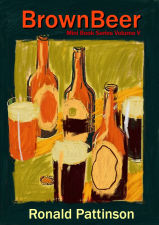Let's get the ball rolling with the Holyrood brewery. There's not much to the grists. There are only two elements: pale malt and dextro-maltose. And they appear in every beer, other than S XP. Though the percentages do vary a bit, from 7% to over 11%.
There does seem to be some logic to this, with beers such as No. 1, which were going to be aged longer, receiving the most sugar. The function of the dextro-maltose being to provide food for the Brattanomyces during the long, slow secondary fermentation.
There are a few more ingrdients at the Abbey brewery. Which makes sense as they brewed a broader range of styles. Though more than half of the beers are 100% pale malt.
The three Stouts all contain black malt in addition to the pale malt. But no other coloured malts, such as crystal, amber or brown. Instead, they go for the simplest possible Stout grist. Not even with any sugar.
Here, the role of the dextro-maltose is very clear. It's present only in the numbered Strong Ales and the Shilling Ales. Beers which were going to be aged. With the sogar being there as Brettanomyces food. Though, at the time, they had no idea that it was Brattanomyces they were feeding. Secondary fermentation being something of a mystery.
Hops. You'll be interested in those, won't you? Everyone is into hops nowadays. We'll be looking at those next.
| William Younger (Holyrood) grists in 1884 | |||
| Beer | Style | pale malt | dextro-maltose |
| S XP | IPA | 100.00% | 0.00% |
| XP | IPA | 92.00% | 8.00% |
| XXP | IPA | 92.86% | 7.14% |
| XXX | Mild | 91.67% | 8.33% |
| XXXX | Mild | 91.67% | 8.33% |
| XXXX / 3 | Mild | 88.57% | 11.43% |
| Ext | Pale Ale | 90.00% | 10.00% |
| S Ext | Pale Ale | 95.12% | 4.88% |
| PX | Pils | 91.67% | 8.33% |
| 1 | Strong Ale | 88.57% | 11.43% |
| 3 | Strong Ale | 92.59% | 7.41% |
| Source: | |||
| William Younger brewing record held at the Scottish Brewing Archive, document number WY/6/1/3/11. | |||
| William Younger (Abbey) grists in 1885 | |||||
| Beer | Style | pale malt | black malt | dextro-maltose | Sacc. |
| T | Table Beer | 100.00% | |||
| 50/- | Ale | 100.00% | |||
| S 50/- | Ale | 100.00% | |||
| B 50/- | Ale | 95.12% | 4.88% | ||
| H 60/- | Ale | 100.00% | |||
| 60/- | Ale | 100.00% | |||
| 80/- | Ale | 100.00% | |||
| 100/- | Ale | 100.00% | |||
| 120/- | Ale | 91.89% | 8.11% | ||
| 140/- | Ale | 87.40% | 12.60% | ||
| 160/- | Ale | 87.40% | 12.60% | ||
| X | Mild | 100.00% | |||
| XX | Mild | 100.00% | |||
| XXX | Mild | 100.00% | |||
| XXXX | Stock Ale | 100.00% | |||
| P | Pale Ale | 100.00% | |||
| XP | IPA | 100.00% | |||
| XP Scotch | Pale Ale | 100.00% | |||
| DBS | Stout | 93.10% | 6.90% | ||
| S1 | Stout | 92.86% | 7.14% | ||
| S2 | Stout | 92.00% | 8.00% | ||
| 1 | Strong Ale | 90.48% | 9.52% | ||
| 2 | Strong Ale | 90.00% | 10.00% | ||
| 3 | Strong Ale | 89.69% | 10.31% | ||
| 3 pale | Strong Ale | 100.00% | |||
| Source: | |||||
| William Younger brewing record held at the Scottish Brewing Archive, document number WY/6/1/2/31. | |||||











































































No comments:
Post a Comment